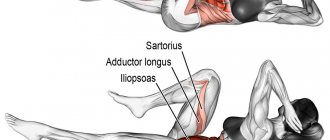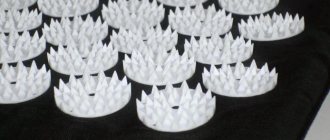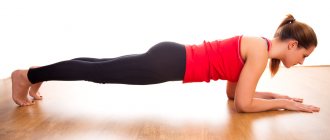Vacuum abdominal exercises are believed to help train the internal abdominal muscles. That is why many trainers recommend including them in the training program for anyone who wants to get rid of extra centimeters on the waist. After all, even the most naturally slender people have a layer of fat in this area. Albeit to a small extent.
What is a vacuum exercise?
A vacuum is an exercise during which you need to exhale the air completely, empty your lungs, and then hold your breath and pull in your stomach as much as possible. After holding this for a certain time, you need to relax and take a deep breath. Vacuum exercises help strengthen the internal abdominal muscles. If you do them regularly, and most importantly, correctly, the core muscles develop and the stomach becomes toned.
However, not everyone can perform a vacuum, and not always. Thus, you should not include exercise in the training program during menstruation, pregnancy, uterine fibroids, acute infectious diseases of the abdominal and pelvic organs, exacerbations of chronic digestive diseases, thromboembolic disease, as well as malignant tumors of any location.
Vacuum
Vacuum is considered to be a very effective exercise for strengthening the abdominal muscles and shaping the waist. Recommendations for performing this exercise boil down to one thing - it must be done on an empty stomach and every morning, and preferably every evening.
Execution technique
The exercise is performed standing or lying down.
- Take the most straight position possible.
- Take a deep breath and then exhale completely.
- After exhaling all the air, you need to hold your breath and draw in your stomach. To create the right vacuum, you need to use not only the lower abdomen, but pull it up, feeling how the internal organs are pressed.
- Fix in this position, do not breathe as much as possible, feel the vacuum.
- Gently relax and breathe.
This practice can include from 3 to 10 repetitions.
Read more about contraindications to performing a vacuum
Despite the obvious benefits of this exercise, in some situations it can harm your health. For those who have chronic diseases, it is better to consult a doctor before including it in the program. Thus, vacuum is not recommended for:
- stomach ulcer and gastritis;
- other gastrointestinal diseases;
- pathologies of the heart and blood vessels;
- blood pressure problems;
- thrombosis;
- hernia.
In addition, you should refrain from performing the exercise in the first six months after abdominal surgery and during menstruation.
If, while doing a vacuum, you feel pain in your stomach, which stopped immediately as soon as you stopped doing it, take a week's break. After 7 days, try again. In a situation where pain is present again during movement, be sure to consult a doctor. Perhaps such loads are contraindicated for you.
How to determine diastasis
To check for the presence of diastasis of the white line of the abdomen, you should perform a simple test. The patient, lying on his back, should bend his knees and place his feet on the floor. Next, bend your neck and slightly tense your abdominal muscles; To do this, just rise a little. Use your fingers to explore the navel and midline area. The appearance of a roller-like protrusion along the midline of the abdomen with smooth contours indicates pathology. It is a little more difficult to identify the disease in people who are obese. More accurate information can be obtained using ultrasound of the anterior abdominal wall.
To determine the stage of diastasis and indications for surgery, as well as to choose the correct surgical treatment tactics, you need to send me a photo of the abdomen in frontal and lateral projection in an inflated and calm state (can be taken with a phone) to my personal email address. Optimally, a complete description of the ultrasound of the abdominal cavity and anterior abdominal wall, preferably an examination by a surgeon, indicate age and main complaints. Then I will be able to give a more accurate answer to your situation.
Stage I
- expansion of the white line in the navel area up to 3 cm.
Stage II
- discrepancy reaches 3-6 cm.
Stage III
- characterized by a diastasis of more than 6 cm.
Why do the vacuum exercise?
Those who have to watch their diet in order not to gain weight should pay attention to the vacuum first. Of course, static exercises alone will not be enough to achieve a wasp waist. You can’t do without dynamic ones, which help to work the rectus and oblique external abdominal muscles. Only a competent combination of these and other exercises within the training scheme will help achieve the desired results.
Along with the common plank, the vacuum helps train the transverse muscles. The transverse muscles perform one of the most important functions in the human body - they support the internal organs of the abdominal cavity and the spine. At the same time, they are considered the most problematic area. After all, it is quite difficult to set a sufficient load during transverse training (due to the depth of this muscle group).
Without systematically performing targeted exercises, the transverse muscles quickly relax, stretch, and become overgrown with fat deposits. It is very difficult to return them to their previous shape later.
If you perform the abdominal vacuum exercise correctly, you can feel how not only the abdominal muscles, but also the diaphragm are involved in the work. That is, this movement teaches the athlete to breathe deeply. Thanks to it, lung capacity increases and problems with posture disappear. In addition, during the vacuum process, a light massage of the internal organs occurs. Yoga adherents believe that such indirect massage increases metabolism in the human body.
Benefits of Exercise
When planning to include a vacuum in your training program, you should know what benefits its regular implementation will bring:
- Reducing waist size.
- No need to use special sports equipment.
- Increased neuromuscular connection with the abdominal muscles.
- Strengthening the diaphragm and increasing lung capacity.
- Improved blood circulation.
- Regular gentle massage of internal organs.
- Strengthening the back muscles, straightening the posture.
- Calming effect on the nervous system.
Of course, it is a mistake to think that you will be able to achieve tangible results just a week from the start of classes.
To achieve the desired result (a thin waist and a flat stomach), you need to perform vacuum press exercises constantly. And of course, supplement the complex with other movements (dynamic), as well as adhere to proper nutrition.
How to do it right
You can perform the vacuum movement standing, kneeling, sitting or lying down.
Vacuum while lying down
The simplest implementation option. Perfect for beginners who are just starting to master such exercises.
Lie on your back, bend your knees, extend your arms along your body or place them on your stomach.
Exhale smoothly, feel how your lungs are completely freed from air. Tighten your abdominal muscles as much as possible, drawing in your stomach (as if you are trying to pull it towards your spine). Stay in this position for 10-15 seconds. Now take a shallow breath, trying not to relax your muscles. Repeat several times, then relax and regain your breathing.
Seated technique
You can do this exercise either sitting on a chair or on your shins. Try both options and decide which one is more convenient for you.
Take a sitting position, place your hands on your hips, keep your back straight.
Inhale and exhale deeply, completely releasing the air from your lungs. After exhaling, pull your stomach in as much as possible, as if you are trying to press it to your spine. Stay in this position for 10-15 seconds (do not inhale). After the specified time has passed, relax and restore your breathing.
Performing the exercise while standing
This is the main method, which should be switched to after mastering the previous techniques.
Stand straight, spread your legs slightly so that your feet are hip-width apart. Now bend over a little and place your palms on your thighs.
Take a deep breath and exhale through your nose. Completely emptying the lungs of air. At the same time, pull the walls of the abdominal cavity towards the spine as much as possible (pull your stomach in strongly).
Hold your breath for 5-10 seconds. Don't relax, keep holding the "belly under the ribs." Make sure your back remains straight. Exhale smoothly, repeat the exercise after 20-30 seconds.
Kneeling technique
This execution variation is more complicated. Suitable for those who have successfully dealt with the previous methods.
Get on your knees, place your palms on them. Next, smoothly lower yourself to a sitting position, but in such a way that there is at least 20 cm between your buttocks and feet. Lean forward a little, try to round your back.
Now take a deep breath and exhale and draw in your stomach as much as possible, holding your breath. Try to hold this position for 20-30 seconds. After the time has passed, inhale and exhale again and retract the abs.
Details about the technique
We actively begin to inhale the air, without opening our mouth, we breathe through our nose. Then we swallow, then exhale with the sounds “Pfa.”
Next, the chin is pressed to the chest. We hold our breath when we exhale completely. Your hands should be on your knees. The next step is to twist the buttocks and pull in the abdomen as much as possible.
If you make a vacuum in the abdomen for the abs in this way, it will be drawn in right up to the ribs and all the way down the back.
That is, if the abdomen vacuum is performed correctly for the abs, it will “stick” and stretch. You will feel it in a split second. Then you need to lift your chin, relax your abs, stop controlling your breathing and inhale gently.
When you learn how to do a vacuum correctly, then complicate the exercise a little by repeating the whipping pushes five times. Once you have a good workout, you can do the exercise during the day. Just don't eat anything before.
A useful video on how to do a belly vacuum for abs is given below.
Many people ask how to do a abdominal vacuum for the press while lying down, if it doesn’t work while standing.
This technique is called pumping and is a precursor to vacuum.
How to make a pump?
The technique is:
- We lie down with our stomach up.
- We bend our knees and place our hands on the bottom of our abs.
- Next, inhale as deeply as possible, while holding your breath.
- Pull your stomach in and push it down to the bikini line.
- Exhale calmly.
The exercise removes excess belly fat, tightens it and prepares you to do a abdominal vacuum for lying abs.
Lie down, press your shoulder blades tightly to the surface. The legs are bent at the knees. Place your feet on the floor. Exhale and inhale. Next, you need to exhale deeply and hold your breath. Then, on the contrary, take a deep breath. You should feel the diaphragm retract and the chest expand. You should get a kind of connection between the stomach and back. When you feel it, hold your breath, then exhale.
Let's look at the technique of performing a abdominal vacuum for the press while standing:
- Inhale slowly and deeply through your nose.
- You should feel your lungs filling with air.
- Exhale powerfully. Feel how your navel is “glued” to your spine.
- Fix your body position for 15-20 seconds.
- Inhale and return your abdominal muscles to their original position.
Tips for Beginners
For those who are just beginning to comprehend the basics of the technique of performing vacuum exercises, it is better to adopt the simplest method - lying down.
Get into the habit of starting your morning with this movement. Right in bed, before you get up and have breakfast, lie on your back, bend your knees. Exhale, completely emptying your lungs of air. At the same time, tighten your abdominal muscles as much as possible, drawing in your stomach. You need to hold your breath in this position for as long as your body allows you. Now inhale, trying not to relax too much, and exhale again. Repeat the exercise several times.
At first, it is enough to hold the vacuum for 10-15 seconds in 3-5 approaches. But gradually the load needs to be increased, including a vacuum in the morning complex from a sitting and standing position.
How many times should you do it and how often?
You can do this exercise every day, but it is better to include it in the main complex 3-4 times a week. This way you will achieve greater efficiency and see results faster.
Beginners need to hold their breath for 10-12 seconds, experienced athletes - for 15-20. The duration of execution should be gradually increased, starting from 15 and eventually reaching 60 seconds.
Vacuum press training program
At the initial stage of training, when you have just started mastering the technique, you should perform 5-6 approaches for 15-20 seconds. You need to rest no more than 1 minute between sets.
By doing a vacuum in this mode for a week, you will feel that the exercise has become easier. This means that the load needs to be increased. Now try to pull your stomach in as much as possible for a longer time - 30-35 seconds. After another 7-14 - at 45-50, etc.
Don't forget that the total duration of the workout should not exceed 25-30 minutes. Afterwards, an adverse effect begins on the nerve endings of the gastrointestinal tract, which can lead to a number of unpleasant consequences (heartburn, bloating, etc.).
Vacuumization of the press / Exercise Vacuum for the abdomen
Good day! Today I would like to share with you my experience in practicing the press vacuumization technique.
I first learned about the press vacuumization technique from a review by a Lady of Southern Blood. After I had previously successfully practiced another method for strengthening the abdominal muscles, namely passive abs, this option also seemed quite successful to me, so I decided to try it. But, as it turned out later, this type of training is not suitable for everyone and may not only not help the abs, but also harm the body itself, worsening its general condition.
What is press vacuumization?
The essence of vacuumization is to draw the stomach in as much as possible, while forcefully exhaling (or even pushing) air from the diaphragm and lungs. Do not strain, as with a passive press, but push out and exhale! And this is not at all as simple as it seems at first glance; you always need to make sufficient efforts for this.
What is needed for this?
As with a passive press, vacuumization requires absolutely no additional equipment. Of course, this is a huge plus of this technique, because you can do with the bare minimum; there is no need even for a special mat, since this exercise must be performed while standing, and not lying down or sitting. Saving money in action, as they say, which is good news
When can you practice vacuuming the press?
Unlike a passive press, during vacuumization certain conditions must be observed. Firstly, this technique must be carried out strictly on an empty stomach. Why, I think, is clear to everyone) Secondly, for this you need to allocate at least 5-10 minutes of free time a day, and also acquire a small space where you can do the exercise while standing.
What does press vacuuming look like in action?
I get into the position that is most comfortable for me and begin to take a deep breath. After this, I exhale as much as possible and draw in my stomach so that it practically sticks to the spine. At least, this is how it feels. In this position, I hold the muscles for about 10-20 seconds, then relax and start all over again. And I do at least 16 such repetitions, that is, about 10 minutes.
*The quality of the photo, of course, leaves much to be desired, but there is no one to photograph me now, so this is the only option left) But the main thing is that you can see exactly how the exercise should be performed.
What does it feel like?
For me, the sensations are not very pleasant. Firstly, I almost immediately begin to feel dizzy, which then leads to headaches. Of course, I didn’t want to torture my body and limited myself to a ten-minute workout every day for a week, but even that gives such an effect. For people with problem lungs, this technique is clearly not suitable.
What is the result?
After a week of practicing the press vacuumization technique, I was even able to get quite a noticeable result. The muscles have become more toned and the stomach has become more elastic. But in addition, I received extremely unpleasant sensations somewhere inside, as if the internal organs were indignant from such exercises. And during the vacuumization itself, my condition could not be called satisfactory, because dizziness and then headaches did not give me strength.
Therefore, I stopped doing vacuumization and returned to the usual passive press, which, although it does not give results so quickly, certainly does not cause such side effects. This is the state my stomach was in after one month of passive abs. It seems to me that it is better to spend a little more time on yourself and get guaranteed results, than to then suffer from various sores caused by training with a quick effect, like vacuumization.
After practicing the passive press technique
As you already understand, I liked the vacuumization of the press because it was a quick and fairly visible result, but a number of significant disadvantages completely overshadowed all the advantages. In general, with the advent of free time, I started normal training, for example, abdominal pumping, which gives the effect no worse, but without any problems for my body. And vacuumization is absolutely not my thing.
Yes, vacuumizing the press did not suit me personally; I noticed no visible effect from this technique within a week, but it simply doesn’t make sense to continue any longer with such a side effect. Of course, you can try it too, but I don't recommend it!
Thank you for reading my review to the end. I’m glad if it was useful for you) If you have any questions, please contact me, I will definitely answer)










